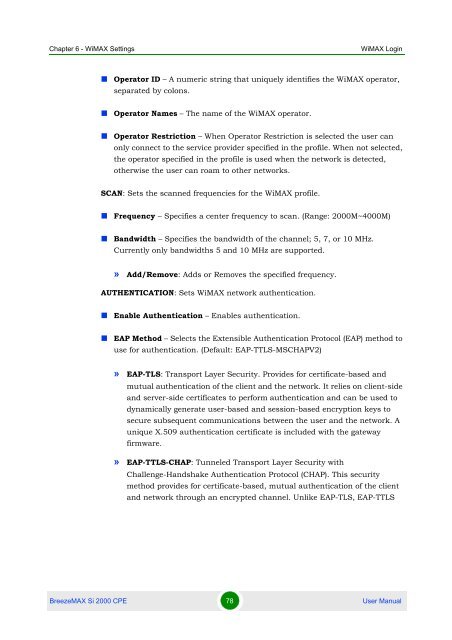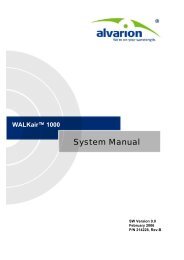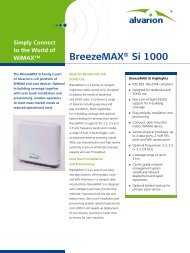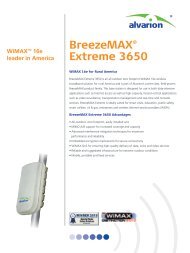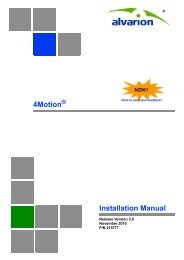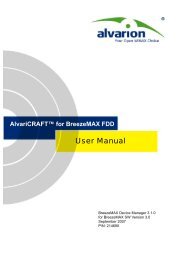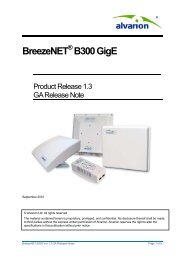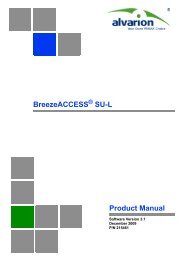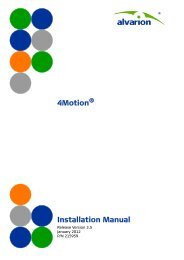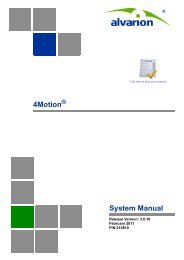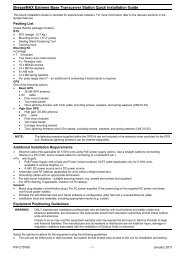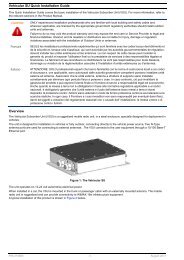BreezeMAX Si 2000 CPE User Manual - Alvarion
BreezeMAX Si 2000 CPE User Manual - Alvarion
BreezeMAX Si 2000 CPE User Manual - Alvarion
Create successful ePaper yourself
Turn your PDF publications into a flip-book with our unique Google optimized e-Paper software.
Chapter 6 - WiMAX Settings<br />
WiMAX Login<br />
• Operator ID – A numeric string that uniquely identifies the WiMAX operator,<br />
separated by colons.<br />
• Operator Names – The name of the WiMAX operator.<br />
• Operator Restriction – When Operator Restriction is selected the user can<br />
only connect to the service provider specified in the profile. When not selected,<br />
the operator specified in the profile is used when the network is detected,<br />
otherwise the user can roam to other networks.<br />
SCAN: Sets the scanned frequencies for the WiMAX profile.<br />
• Frequency – Specifies a center frequency to scan. (Range: <strong>2000</strong>M~4000M)<br />
• Bandwidth – Specifies the bandwidth of the channel; 5, 7, or 10 MHz.<br />
Currently only bandwidths 5 and 10 MHz are supported.<br />
» Add/Remove: Adds or Removes the specified frequency.<br />
AUTHENTICATION: Sets WiMAX network authentication.<br />
• Enable Authentication – Enables authentication.<br />
• EAP Method – Selects the Extensible Authentication Protocol (EAP) method to<br />
use for authentication. (Default: EAP-TTLS-MSCHAPV2)<br />
» EAP-TLS: Transport Layer Security. Provides for certificate-based and<br />
mutual authentication of the client and the network. It relies on client-side<br />
and server-side certificates to perform authentication and can be used to<br />
dynamically generate user-based and session-based encryption keys to<br />
secure subsequent communications between the user and the network. A<br />
unique X.509 authentication certificate is included with the gateway<br />
firmware.<br />
» EAP-TTLS-CHAP: Tunneled Transport Layer Security with<br />
Challenge-Handshake Authentication Protocol (CHAP). This security<br />
method provides for certificate-based, mutual authentication of the client<br />
and network through an encrypted channel. Unlike EAP-TLS, EAP-TTLS<br />
<strong>BreezeMAX</strong> <strong>Si</strong> <strong>2000</strong> <strong>CPE</strong> 78 <strong>User</strong> <strong>Manual</strong>


